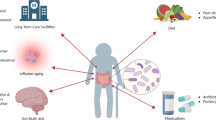Abstract
Longevity is different for every animal species as well as their genome, suggesting a correlation between genes and life-span. Estimates put the genetic effect from 5 to 35 % approximately, suggesting that even genetic effects are dependent on environmental conditions. This contention is largely confirmed by the study of identical twins raised apart. They do not die at the same age and also for different reasons. Aging is not “genetically programmed”, it is outside evolutionary constraint. Evolution favors early and efficient reproduction, but does not care for longevity. A number of mechanisms were shown to be involved in the age-dependent decline of vital functions, among them the Maillard reaction (non-enzymatic glycosylation) and the age-dependent upregulation of proteolytic activity. Aging of ECM is a complex process, comprising progressive modification of its macromolecular components and of cell-matrix interactions. An important process is the uncoupling with age of the elastin-receptor from its “young” transmission pathway loosing all physiological effects, but enhancing free radical and elastase release. These processes contribute to age-related ECM degradation, production of matrikins (ECM degradation products with biological activity) aggravating functional loss with age. Both genetic and post-genetic mechanisms are susceptible to be influenced by medical, pharmacological and dietary interventions. Among the genetic mechanisms, those attributed to Sirtuins (7 orthologs identified in the human genome) are especially important. Among the environmental effects, nutrition, hygiene and weather conditions play a role. These data justify some predictions on the evolution of life expectancy taking in account also socio-economic factors. Biological constraints become evident by the comparison of centenarians and supercentenarians (less than 1 % of the centenarians) putting an upper limit to the attainable human lifespan.
Similar content being viewed by others
References
Allard M, Robine JM (2000) Les centenaires français Etude de la Fondation IPSEN. Serdi Edition, Paris
Coles LS (2013) Validated worldwide supercentenarians, living and recently deceased. Rejuvenation Res 16:82–84. doi:10.1089/rej.1411
Fülöp T, Barabas G, Varga ZS, Csongor J, Hauck M, Szucs S, Seres I, Mohacsi A, Kekessy D, Despont JP, Robert L, Penyige A (1992) Transmembrane signaling changes with aging. Ann N Y Acad Sci 673:165–171
Hayflick L (1965) The limited in vitro lifetime of human diploid cell strains. Exp Cell Res 37:614–636
Hornebeck W, Tixier JM, Robert L (1986) Inducible adhesion of mesenchymal cells to elastic fibers: elastonectin. Proc Natl Acad Sci USA 83:5517–5520
Jacob F (1977) Evolution and tinkering. Science 196:1161–1166
Koubova J, Guarente L (2003) How does calorie restriction work? Genes Dev 17:313–321
Lakatta EG (1986) An integrated approach toward understanding myocardial aging. In: Bergener M, Ermini M, Stähelin HB (eds) Dimensions in aging. The 1986 Sandoz lectures in gerontology. Academic Press Inc, London
Li L, Liu L, Tollefsbol TO (2010) Glucose restriction can extend normal cell lifespan and impair precancerous cell growth through epigenetic control of hTRT and p16 expression. FASEB J 24:1442–1453. doi:10.1096/fj.09-149328
Mattison JA, Roth GS, Beasley M, Tilmont EM, Handy AM, Herbert RL et al (2012) Impact of caloric restriction on health and survival in rhesus monkeys from the NIA study. Nature 489:318–321
McCay CM, Maynard LA, Sperling G, Barnes LL (1939) Retarded growth, lifespan, ultimate body size and age changes in the albino rat after feeding diets restricted in calories. J Nutr 18:1–13
Olshansky SJ, Douglas J, Passaro MD, Ronald C, Hershow MD, Layden J et al (2005) A potential decline in life expectancy in the United States in the 21st century. N Engl J Med 322:1138–1145
Robert L (1998) Mechanisms of aging of the extracellular matrix. Role of the elastin-laminin receptor Novartis prize lecture. Gerontology 44:307–317
Robert L (2012) Longevity and aging, genetic and post-genetic mechanisms. Which target to choose for postponing and treating age-related diseases. Eur Geriatr Med 3:61–66
Robert L (2013) Calorie-restriction and longevity. End of a dream, at least for primates. Eur Geriatr Med Elsevier 4:129–132
Roth GS (1995) Changes in tissue responsiveness to hormones and neurotransmitters during aging. Exp Gerontol 30:361–368
Segal NL (2012) Born together—reared apart. The landmark Minnesota twin study. Harvard University Press, Cambridge
Walford LR, Harris SB, Weindruch B (1987) Dietary restriction and aging. Historical phases, mechanisms and current directions. J Nutr 117:1650–1654
Author information
Authors and Affiliations
Corresponding author
Rights and permissions
About this article
Cite this article
Robert, L., Labat-Robert, J. Longevity and aging: role of genes and of the extracellular matrix. Biogerontology 16, 125–129 (2015). https://doi.org/10.1007/s10522-014-9544-x
Received:
Accepted:
Published:
Issue Date:
DOI: https://doi.org/10.1007/s10522-014-9544-x




